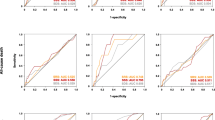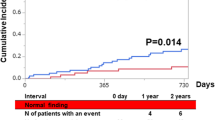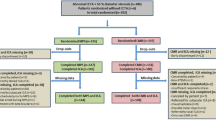Abstract
A fatty acid analogue, 123I-labelled β-methyl iodophenyl pentadecanoic acid (BMIPP), has been used to identify ischaemic and metabolically impaired myocardium. However, the prognostic value of BMIPP imaging, particularly in relation to stress myocardial perfusion imaging, remains unclear. Data from 167 consecutive patients with angina pectoris but without prior myocardial infarction (MI) who had undergone both BMIPP and stress 201Tl (sTL) imaging were analysed. Tracer uptake was graded using a 13-segment, 4-point scoring model. Patients were followed up for 48 months with primary end points (cardiac death, non-fatal MI) as hard cardiac events and with secondary end points (late revascularisation, recurrent angina and heart failure) as soft events. For overall cardiac events (5 hard and 29 soft events), Kaplan-Meier analysis revealed significantly lower event rates in subgroups with normal BMIPP uptake, a summed difference score of sTL (SDS) of <3 or absence of diabetes mellitus when compared to each counterpart. Multivariate Cox’s analysis revealed reduced BMIPP uptake, SDS ≥3, diabetes and reduced ejection fraction to be significant predictors. Negative predictive values of normal BMIPP and SDS <3 for all events were 91% and 84%, respectively. No hard event occurred in 66 patients with normal BMIPP uptake, whereas two patients with SDS <3 but impaired BMIPP uptake had hard events. In conclusion, normal BMIPP imaging is an excellent prognostic sign, independently of stress myocardial perfusion imaging, in patients with angina pectoris without prior MI.


Similar content being viewed by others
References
Gibbons RJ, Hodge DO, Berman DS, et al. Long-term outcome of patients with intermediate-risk exercise electrocardiograms who do not have myocardial perfusion defects on radionuclide imaging. Circulation 1999;100:2140–5
Hachamovitch R, Berman DS, Kiat H, et al. Value of stress myocardial perfusion single photon emission computed tomography in patients with normal resting electrocardiograms: an evaluation of incremental prognostic value and cost-effectiveness. Circulation 2002;105:823–9
Diaz LA, Brunken RC, Blackstone EH, et al. Independent contribution of myocardial perfusion defects to exercise capacity and heart rate recovery for prediction of all-cause mortality in patients with known or suspected coronary heart disease. J Am Coll Cardiol 2001;37:1558–4
Galassi AR, Azzarelli S, Tomaselli A, et al. Incremental prognostic value of technetium-99m-tetrofosmin exercise myocardial perfusion imaging for predicting outcomes in patients with suspected or known coronary artery disease. Am J Cardiol 2001;88:101–6
Nakata T, Kobayashi T, Tamaki N, et al. Prognostic value of impaired myocardial fatty acid uptake in patients with acute myocardial infarction. Nucl Med Commun 2000;21:897–906
Tamaki N, Tadamura E, Kudoh T, et al. Prognostic value of iodine-123 labelled BMIPP fatty acid analogue imaging in patients with myocardial infarction. Eur J Nucl Med 1996;23:272–9
Nishimura S, Ohta Y. BMIPP in angina pectoris. Int J Card Imaging 1999;15:35–9
Braunwald E. Unstable angina. A classification. Circulation 1989;80:410–4
Gould KL, Westcott RJ, Albro PC, et al. Noninvasive assessment of coronary stenoses by myocardial imaging during pharmacologic coronary vasodilatation. II. Clinical methodology and feasibility. Am J Cardiol 1978;41:279–87
Watanabe K, Sekiya M, Ikeda S, et al. Comparison of adenosine triphosphate and dipyridamole in diagnosis by thallium-201 myocardial scintigraphy. J Nucl Med 1997;38:577–81
Tamaki N, Kuge Y, Tsukamoto E. Clinical roles of perfusion and metabolic imaging. J Cardiol 2001;37(Suppl 1):57–64
Yamabe H, Fujiwara S, Rin K, et al. Resting 123I-BMIPP scintigraphy for detection of organic coronary stenosis and therapeutic outcome in patients with chest pain. Ann Nucl Med 2000;14:187–92
Kawai Y, Tsukamoto E, Nozaki Y, et al. Significance of reduced uptake of iodinated fatty acid analogue for the evaluation of patients with acute chest pain. J Am Coll Cardiol 2001;38:1888–94
Morimoto K, Tomoda H, Yoshitake M, et al. Prediction of coronary artery lesions in unstable angina by iodine 123 beta-methyl iodophenyl pentadecanoic acid (BMIPP), a fatty acid analogue, single photon emission computed tomography at rest. Angiology 1999;50:639–48
Schwaiger M, Schelbert HR, Ellison D, et al. Sustained regional abnormalities in cardiac metabolism after transient ischemia in the chronic dog model. J Am Coll Cardiol 1985;6:336–47
Hashimoto A, Nakata T, Tsuchihashi K, et al. Postischemic functional recovery and BMIPP uptake after primary percutaneous transluminal coronary angioplasty in acute myocardial infarction. Am J Cardiol 1996;77:25–30
Nakata T, Hashimoto A, Kobayashi H, et al. Outcome significance of thallium-201 and iodine-123-BMIPP perfusion-metabolism mismatch in preinfarction angina. J Nucl Med 1998;39:1492–9
Tateno M, Tamaki N, Yukihiro M, et al. Assessment of fatty acid uptake in ischemic heart disease without myocardial infarction. J Nucl Med 1996;37:1981–5
Nakajima K, Shimizu K, Taki J, et al. Utility of iodine-123-BMIPP in the diagnosis and follow-up of vasospastic angina. J Nucl Med 1995;36:1934–40
Takeishi Y, Sukekawa H, Saito H, et al. Clinical significance of decreased myocardial uptake of 123I-BMIPP in patients with stable effort angina pectoris. Nucl Med Commun 1995;16:1002–8
Nishizaki M, Arita M, Sakurada H, et al. Polymorphic ventricular tachycardia in patients with vasospastic angina—clinical and electrocardiographic characteristics and long-term outcome. Jpn Circ J 2001;65:519–25
Sharir T, Germano G, Kavanagh PB, et al. Incremental prognostic value of post-stress left ventricular ejection fraction and volume by gated myocardial perfusion single photon emission computed tomography. Circulation 1999;100:1035–42
Acknowledgements
We thank Dr. Takeshi Ashie, MD, Mr. Kazumasa Tsukamoto and Mr. Masatsuyo Takano, RT, for their cooperation and encouragement.
Author information
Authors and Affiliations
Corresponding author
Rights and permissions
About this article
Cite this article
Matsuki, T., Tamaki, N., Nakata, T. et al. Prognostic value of fatty acid imaging in patients with angina pectoris without prior myocardial infarction: comparison with stress thallium imaging. Eur J Nucl Med Mol Imaging 31, 1585–1591 (2004). https://doi.org/10.1007/s00259-004-1551-8
Received:
Accepted:
Published:
Issue Date:
DOI: https://doi.org/10.1007/s00259-004-1551-8




